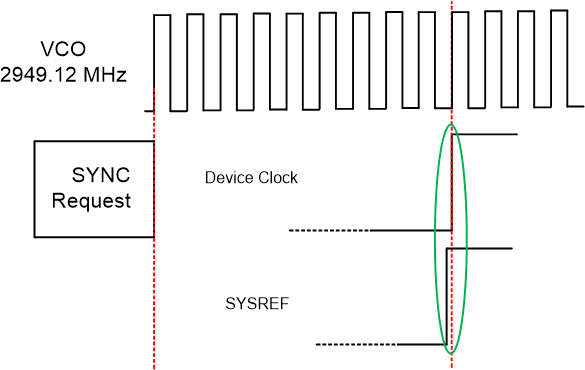JAJSO88 October 2023 LMK04714-Q1
PRODUCTION DATA
- 1
- 1 特長
- 2 アプリケーション
- 3 概要
- 4 Revision History
- 5 Pin Configuration and Functions
- 6 Specifications
- 7 Parameter Measurement Information
-
8 Detailed Description
- 8.1 Overview
- 8.2 Functional Block Diagram
- 8.3 Feature Description
- 8.4 Device Functional Modes
- 8.5 Programming
- 8.6
Register Maps
- 8.6.1 Register Map for Device Programming
- 8.6.2
Device Register Descriptions
- 8.6.2.1 System Functions
- 8.6.2.2
(0x100 to 0x137) Device Clock and SYSREF Clock Output
Controls
- 8.6.2.2.1 DCLKX_Y_DIV
- 8.6.2.2.2 DCLKX_Y_DDLY
- 8.6.2.2.3 CLKoutX_Y_PD, CLKoutX_Y_ODL, CLKoutX_Y_IDL, DCLKX_Y_DDLY_PD, DCLKX_Y_DDLY[9:8], DCLKX_Y_DIV[9:8]
- 8.6.2.2.4 CLKoutX_SRC_MUX, DCLKX_Y_PD, DCLKX_Y_BYP, DCLKX_Y_DCC, DCLKX_Y_POL, DCLKX_Y_HS
- 8.6.2.2.5 CLKoutY_SRC_MUX, SCLKX_Y_PD, SCLKX_Y_DIS_MODE, SCLKX_Y_POL, SCLKX_Y_HS
- 8.6.2.2.6 SCLKX_Y_ADLY_EN, SCLKX_Y_ADLY
- 8.6.2.2.7 SCLKX_Y_DDLY
- 8.6.2.2.8 CLKoutY_FMT, CLKoutX_FMT
- 8.6.2.3
SYSREF, SYNC, and Device Config
- 8.6.2.3.1 VCO_MUX, OSCout_MUX, OSCout_FMT
- 8.6.2.3.2 SYSREF_REQ_EN, SYNC_BYPASS, SYSREF_MUX
- 8.6.2.3.3 SYSREF_DIV
- 8.6.2.3.4 SYSREF_DDLY
- 8.6.2.3.5 SYSREF_PULSE_CNT
- 8.6.2.3.6 PLL2_RCLK_MUX, PLL2_NCLK_MUX, PLL1_NCLK_MUX, FB_MUX, FB_MUX_EN
- 8.6.2.3.7 PLL1_PD, VCO_LDO_PD, VCO_PD, OSCin_PD, SYSREF_GBL_PD, SYSREF_PD, SYSREF_DDLY_PD, SYSREF_PLSR_PD
- 8.6.2.3.8 DDLYdSYSREF_EN, DDLYdX_EN
- 8.6.2.3.9 DDLYd_STEP_CNT
- 8.6.2.3.10 SYSREF_CLR, SYNC_1SHOT_EN, SYNC_POL, SYNC_EN, SYNC_PLL2_DLD, SYNC_PLL1_DLD, SYNC_MODE
- 8.6.2.3.11 SYNC_DISSYSREF, SYNC_DISX
- 8.6.2.3.12 PLL1R_SYNC_EN, PLL1R_SYNC_SRC, PLL2R_SYNC_EN, FIN0_DIV2_EN, FIN0_INPUT_TYPE
- 8.6.2.4
(0x146 - 0x149) CLKIN Control
- 8.6.2.4.1 CLKin_SEL_PIN_EN, CLKin_SEL_PIN_POL, CLKin2_EN, CLKin1_EN, CLKin0_EN, CLKin2_TYPE, CLKin1_TYPE, CLKin0_TYPE
- 8.6.2.4.2 CLKin_SEL_AUTO_REVERT_EN, CLKin_SEL_AUTO_EN, CLKin_SEL_MANUAL, CLKin1_DEMUX, CLKin0_DEMUX
- 8.6.2.4.3 CLKin_SEL0_MUX, CLKin_SEL0_TYPE
- 8.6.2.4.4 SDIO_RDBK_TYPE, CLKin_SEL1_MUX, CLKin_SEL1_TYPE
- 8.6.2.5 RESET_MUX, RESET_TYPE
- 8.6.2.6
(0x14B - 0x152) Holdover
- 8.6.2.6.1 LOS_TIMEOUT, LOS_EN, TRACK_EN, HOLDOVER_FORCE, MAN_DAC_EN, MAN_DAC[9:8]
- 8.6.2.6.2 MAN_DAC
- 8.6.2.6.3 DAC_TRIP_LOW
- 8.6.2.6.4 DAC_CLK_MULT, DAC_TRIP_HIGH
- 8.6.2.6.5 DAC_CLK_CNTR
- 8.6.2.6.6 CLKin_OVERRIDE, HOLDOVER_EXIT_MODE, HOLDOVER_PLL1_DET, LOS_EXTERNAL_INPUT, HOLDOVER_VTUNE_DET, CLKin_SWITCH_CP_TRI, HOLDOVER_EN
- 8.6.2.6.7 HOLDOVER_DLD_CNT
- 8.6.2.7 (0x153 - 0x15F) PLL1 Configuration
- 8.6.2.8 (0x160 - 0x16E) PLL2 Configuration
- 8.6.2.9 (0x16F - 0x555) Misc Registers
-
9 Application and Implementation
- 9.1 Application Information
- 9.2 Typical Application
- 9.3 System Examples
- 9.4 Power Supply Recommendations
- 9.5 Layout
- 10Device and Documentation Support
- 11Mechanical, Packaging, and Orderable Information
8.3.5 SYSREF to Device Clock Alignment
To ensure proper JESD204B/C operation, the timing relationship between the SYSREF and the Device clock must be adjusted for optimum setup and hold time as shown in Figure 8-6. The global SYSREF digital delay (SYSREF_DDLY), local SYSREF digital delay (SCLKX_Y_DDLY), local SYSREF half step (SCLKX_Y_HS), and local SYSREF analog delay (SCLKX_Y_ADLY, SCLK2_3_ADLY_EN) can be adjusted to provide the required setup and hold time between SYSREF and Device Clock. It is also possible to adjust the device clock digital delay (DCLKX_Y_DDLY) and half step (DCLK0_1_HS, DCLK0_1_DCC) to adjust phase with respect to SYSREF.
 Figure 8-6 SYSREF to Device Clock Timing
Alignment
Figure 8-6 SYSREF to Device Clock Timing
AlignmentThe delay between clock and SYSREF is the difference between the delays for these paths.
| VARIABLE/FIELD | COMMENTS | EXAMPLE (fVCO = 2.5 GHz, DIVIDE = 6) |
|---|---|---|
|
ClockFixed Delay (DCLKX_Y_DDLY) |
ClockFixedDelay = 6000 ps (DCLK0_1_DDLY = 15) |
|
|
ClockFixedDelayCorrection |
Correction value when divide is less than 8.
|
ClockFixedDelayCorrection = –400 ps (–1 VCO Cycle) |
| ClockDutyCycleCorrect (DCLKX_Y_DCC) |
Adds one VCO cycle if enabled |
ClockDutyCycleCorrect = 400 (DCLKX_Y_DCC = 1) |
|
ClockDynamicDelay (dDLY_STEP_CNT) |
ClockDynamicDelay is the cumulative effect of programming dDLY_STEP_CNT. It is zero if the dynamic delay is disabled for the channel | ClockDynamicDigitalDelay = 0 (DDLYd0_EN = 0) |
| ClockHalfStep (DCLKX_Y_HS) |
This would be ½ of a VCO Cycle if enabled |
ClockHalfStep = 200 (DCLKX_Y_DCC = 1) |
| SysrefGlobalDelay (SYSREF_DDLY) |
SYSREF_DDLY≥8 for proper operation |
SysRefGlobalDelay = 4800 ps (SYSREF_DDLY = 12) |
| SysrefFixedDelay (SCLKX_Y_DDLY) |
This is the number of cycles represented by the delay | SysrefFixedDelay = 2 × 400 = 800 ps (SCLK0_1_DDLY = 1) |
|
SysrefHalfStep (SCLKX_Y_HS) |
The half step for the SYSREF is not exactly a half step, but rather about 60 ps less. |
SysrefHalfStep = 200 – 60 = 140 ps (SCLK0_1_HS = 1) |
|
SysrefAnalogDelay (SCLKX_Y_ADLY) |
This is the stated value in ps for the analog delay |
SysrefAnalogDelay = 230 ps (SCLK0_1_ADLY = 5) |
| TotalClockDelay = 6000 + (–400) + 400 – 200 + 0 = 5800 ps | ||
| TotalSysrefDelay = 80 + 400 + 4800 + 800 – 140 + 230 = 6170 ps | ||
| Clock to SYSREF Delay = 6170 – 5800 = 370 ps | ||